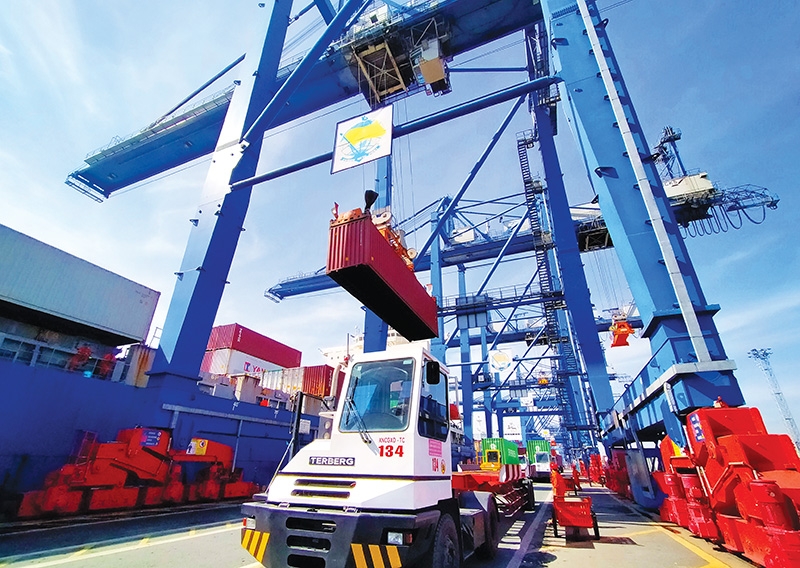with the recommendation that providing practical support for the private sector will help the economy achieve higher growth and create more jobs.
 |
| Businesses are finding it hard to expand and also increase exports. Photo: Le Toan |
It may be the first time that the National Assembly (NA) must implement an unheard-of action – to revise the economy’s growth target down amid the current pandemic, affecting all of Vietnam’s trade and investment partners and the economy’s internal strength.
“Given the existing massive difficulties, the target of 6.8 per cent economic growth is quite a challenge and hard to reach,” Prime Minister Phuc told the NA last week.
According to a government report delivered to the NA, it is crucial to adjust the goals for 2020 which is suitable to the objective reality.
The goals needing to be altered would include GDP, which should increase by 4.5 per cent on-year, which if the pandemic is controlled better in the world and the global market recovers stronger, is expected to climb by 5.4 per cent on-year.
“This is aimed to ensure that GDP can grow 6.5 per cent on average in the 2016-2020 period,” said the report. Thus, the government has prepared two economic growth scenarios.
In the first, with Vietnam controlling COVID-19 in the second half of April and its key investment and trade partners doing this in the third quarter of 2020, GDP is expected to increase 4.4-5.2 per cent on-year in 2020, which is 1.6-2.4 per cent lower than the initial target of 6.8 per cent.
In this, the agro-forestry-fishery sector is expected to climb 2.5-2.8 per cent on-year, the industrial and construction sector is projected to increase 6.7-7.9 per cent on-year, and the service sector 2.8-3.6 per cent on-year.
In the second scenario, with the country quenching the pandemic in the second half of April and its major investment and trade partners doing this in the fourth quarter, GDP is forecast to expand by 3.6-4.4 per cent on-year in this year, which is 2.4-3.2 per cent lower than the initial target of 6.8 per cent. Of this, the agro-forestry-fishery sector will likely rise 2.1-2.5 per cent on-year, while the industrial and construction sector will grow 5.8-6.7 per cent, and the service sector 1.8-2.8 per cent.
Theoretically in Vietnam, it is calculated that a drop of 1 per cent in growth would mean a loss of about 400,000 jobs, excluding the negative impacts of COVID-19 taking away employment opportunities of many millions of other labourers.
PM Phuc said that difficulties are being seen in business and production in all sectors and enterprises in the economy. In the first four months, the number of newly-established enterprises decreased 13.3 per cent on-year, while the number of those halting operations increased strongly. Notably, demand for labour has seriously dropped.
“The pandemic has driven about five million people in Vietnam into unemployment since early this year, 98 per cent of whom are from the tourism, service, and aviation sectors. Some 78 per cent of labourers in the transport, footwear, and textile and garment have faced layoffs,” the PM stressed.
In a specific case, Nguyen Dinh Chien halted the operation of his garment factory in Quang Minh Industrial Park in Hanoi’s Dong Anh district. The factory was only inaugurated in the middle of last year, and is managed by Danh Dat Garment and Trading JSC, where Chien is the director.
The temporary shutdown of the factories, which has cost Chien VND50 billion ($21.7 million), followed no visits by customers since the COVID-19 pandemic hit Vietnam and the government-applied social distancing policy.
“Our firm has halted operations, meaning a big debt from banks and 500 workers left unemployed,” he sighed.
According to the General Statistics Office, in April the number of companies in Vietnam facing a similar plight to Danh Dat was over 4,100, up 68 per cent on-month and 65 per cent on-year. In the first four months, such enterprises numbered 22,700, up 33.6 per cent on-year. The key reason is said to be the devastating effects of the pandemic driving enterprises into great woes.
Hong Sun, vice chairman of the Korea Chamber of Business in Vietnam told VIR that the current time is “extremely difficult” for all businesses, including the 9,000 South Korean ones employing over one million Vietnamese labourers.
“While enterprises are finding it hard to boost exports, it is also extremely difficult for them to expand domestic consumption as consumers are currently tightening their belt,” Sun said. “Some of them have also had layoffs.”
NA deputy Vu Tien Loc, representing the northern province of Thai Binh, said the private sector is facing numerous difficulties caused by both COVID-19 and cumbersome policies, affecting the country’s competitiveness.
“In Vietnam, though creating up to 40 per cent of GDP, the private sector currently embraces a big paradox, in which over 700,000 groups are creating only 10 per cent of GDP, while the remaining 30 per cent of GDP is created by five million business households, including two million with business registration,” said Loc, who is also chairman of the Vietnam Chamber of Commerce and Industry.
“There are no other economies like Vietnam which has such a big ratio of informal and formal economic sectors. The problem is whether the government’s policies have been good enough to help enterprises out of difficulties and grow more,” Loc stressed. VIR
Thanh Thu

PM asks for parliament's approval on lower GDP growth amid virus challenges
The Government of Vietnam is asking the National Assembly to approve a revised down GDP growth, as the coronavirus pandemic continues to ravage the world’s economy.

Vietnam gov't mulls lowering 2020 GDP growth target to 4.5%
A lower GDP growth target is inevitable as the Covid-19 pandemic is wreaking havoc on the world economy, said Minister of Planning and Investment Nguyen Chi Dung.
 The aftermath of the health crisis has prompted Vietnam to consider adjusting its economic growth target, " itemprop="description" />
The aftermath of the health crisis has prompted Vietnam to consider adjusting its economic growth target, " itemprop="description" />